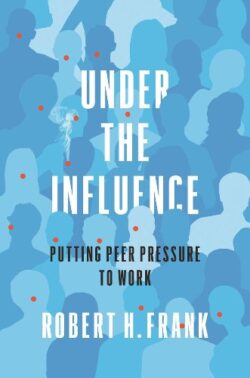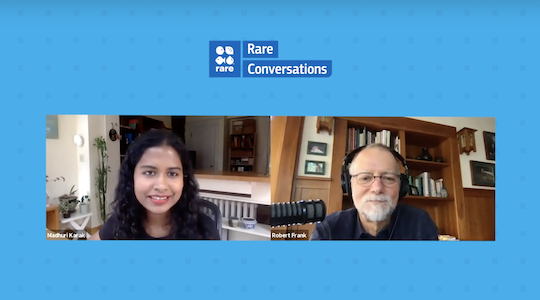In late 2020, Dr. Madhuri Karak, Community Engagement Lead at Rare’s Center for Behavior & the Environment, (virtually) sat down with Dr. Robert H. Frank to discuss climate change, behavioral contagion, and key takeaways from his new book — Under the Influence: Putting Peer Pressure to Work. This discussion was the second installment of “Rare Conversations,” a new virtual engagement series that features conversations between Rare experts and real-life innovators in the field of behavior change and conservation.
As a New York Times bestselling author and a recently-retired Professor of Economics and Management at Cornell University, Robert Frank has a lot to share on the topic of human behavior. For this conversation, Frank focused on the connection between peer pressure, individual action, and public policy as they relate to climate change.

If you missed tuning into the conversation live, don’t worry! Follow along as I dive into a few of the key lessons from this insightful discussion.
- Individual action and policy change can work together on climate.
A commonly held belief among many economists is that focusing on individual action is ineffective in its ability to mitigate climate change or that it distracts from extensive policy changes that need to occur. Although he might have agreed with them a couple of years ago, Frank now firmly opposes this perspective. It’s not that we don’t need a top-down approach to tackle climate change, but rather that focusing on individual behavior can assist in generating the policies necessary to secure our future.
Frank pointed out that individual actions may seem to be “a drop in the bucket” relative to all of the work that needs to be done, but he emphasized the important ripple effects of such actions. To explain this phenomenon, he made a reference to a 2012 study conducted by Bryan Bollinger and Kenneth Gillingham. The experiment found that if one person in a neighborhood installed a solar panel, within four months someone else would follow their lead. Eight months later, those two solar panels would become four. Fast forward two years — that one solar panel has resulted in 32 solar panels across the neighborhood that might not have been installed otherwise. This study illustrates behavioral contagion in action.
- Show off your family’s and friends’ good behavior.
We all know how powerful social media can be in creating momentum for movements. But how can we best harness this modern technology to promote the kind of environmental behavioral contagion that Frank writes about?
There’s a relevant phenomenon called “virtue signaling.” This is the practice of publicly displaying one’s opinion or actions in order to make known their position (particularly a socially-desired one) on a topic or issue. Yet Frank noted that putting our own virtues on display can often be counterproductive. What can be more effective is highlighting someone else doing something positive for the environment. This captures the power of social influence by sharing that other people are currently doing the desired behavior and in turn making it the perceived norm. So, next time you are thinking of posting that picture of yourself making a plant-based meal, it might be more impactful to feature your brother, friend, cousin, etc. cooking instead.
- Focus on the person, not the climate, in climate communication.
Whether it be discussing the validity of climate change with a climate denier or explaining the impacts of meat production to your partner, climate communication is no easy feat.
Frank recommends keeping it simple:
“It’s always better not to try to explain something to somebody unless you’ve been directly asked to do that. Instead, listen attentively and try to indicate interest in what your conversation partner is saying. The main lever you have to get people to think in a fresh way is to ask the right question at the right moment.”
(Check out the chapter “Ask, Don’t Tell” in Under the Influence; Putting Peer Pressure to Work for more climate communication tips.)
Beyond that, advocate for small rather than large changes in behavior. For example, when trying to alter others’ behavior, ‘eat less meat’ may be a more effective message than ‘you should go vegan.’ Mandating that someone give up meat entirely, rather than limit their current consumption, might seem like an unattainable request. While there’s no doubt that we need immediate action, we also need durable action. Frank believes that by taking a more incremental approach to behavior change, you allow room for people to take small steps, slowly changing their environmental identities and limiting potential backfire.

Behavioral contagion is a powerful force.
This conversation highlights one of the main themes from Frank’s new book: we are shaped by our social networks in a multitude of ways. Peer pressure is notorious for promoting harmful behaviors (the kind our parents warned us of), but it can also have socially and environmentally beneficial effects. Beyond the visible forms of influence, like your neighbor’s solar panels, having conversations about environmental actions with friends and family can also generate widespread change. If these behaviors become the norm, we can start securing a future that includes both individual action and comprehensive policies on climate change.
Interested in other conversations like this one? Check out the first installment of this series, where Madhuri discusses how we can “harness ambiguity” in the face of climate change with leading design thinker, Sarah Stein Greenberg. And of course, stay tuned for our next Rare Conversations, where we will continue exploring various topics related to behavior change, conservation, and how people can thrive on a changing planet.
Learn more about Rare’s Center for Behavior & the Environment at behavior.rare.org.